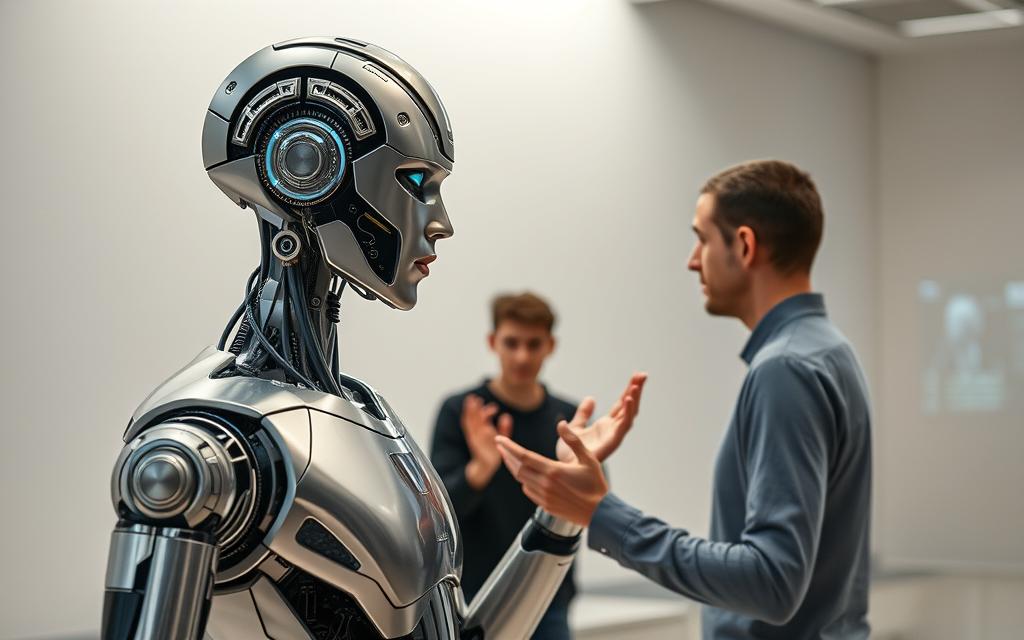Table of Contents
The digital landscape is rapidly evolving, with AI-generated content becoming increasingly prevalent. As a result, the line between human and machine-written text is blurring, creating both opportunities and challenges.
AI humanizers are revolutionizing the way we approach content creation. By transforming robotic-sounding AI-generated content into more human-like text, these tools help ensure that the content feels natural and engaging.
This technology is crucial in bridging the gap between efficient machine-generated content and the emotional resonance that only human writing can provide. As we explore the capabilities of AI humanizers, we’ll examine how they’re reshaping the future of content creation.
The Evolution of AI-Generated Content
The emergence of sophisticated AI writing tools has dramatically changed how we create content. These advanced tools have transformed the writing landscape, offering unprecedented efficiency and the ability to generate vast amounts of content quickly.
The Rise of AI Writing Tools
AI systems like ChatGPT, Google Gemini, and other large language models have revolutionized writing tasks. These AI writing tools have made it possible to produce content at a scale and speed previously unimaginable. The efficiency brought about by these tools has been a game-changer for content creators.
The Challenge of Robotic-Sounding Content
Despite their capabilities, AI writing tools often produce text with recognizable patterns and a distinct “robotic” quality. This mechanical tone poses a challenge for content creators who need their ai-generated text to resonate with audiences on a human level. The limitations of raw AI-generated content have created a new market need: tools that can maintain AI efficiency while infusing output with human-like qualities.
Our AI Humanizer excels at transforming AI content into human text, trained on an extensive corpus of human writing. This sophisticated tool helps humanize AI text, including Humanize ChatGPT text, with remarkable accuracy.
What is an AI Humanizer?
Understanding AI humanizers is crucial for leveraging their potential in content transformation. An AI humanizer is a sophisticated tool designed to bridge the gap between machine-generated content and human-like writing.

Definition and Core Functionality
At its core, an AI humanizer is a specialized tool that transforms machine-generated content into text that mimics human writing patterns, emotional cues, and natural language variations. The core functionality revolves around sophisticated algorithms that analyze and restructure text to eliminate patterns that trigger AI detection systems.
How AI Humanizers Differ from Standard AI Tools
Unlike standard AI writing tools that focus primarily on generating content from prompts, humanizers specifically address the “uncanny valley” problem in AI writing by adding natural imperfections and stylistic elements. This results in content that is not only more relatable but also more engaging for readers.
AI humanizers represent a significant advancement over basic content spinners or paraphrasing tools, as they focus on qualitative improvements rather than simply changing words to avoid plagiarism detection. By humanizing text, these tools preserve the original meaning and context while introducing human-like variations in sentence structure, vocabulary choices, and rhetorical devices, ultimately enhancing the overall content quality.
How AI Humanizers Transform Machine Text into Human Writing
AI Humanizers play a crucial role in transforming machine-generated text into content that resonates with human readers. By leveraging advanced technologies, these tools can significantly enhance the quality and readability of AI-generated content.
The Technology Behind AI Humanization
The technology behind AI humanization involves sophisticated natural language processing algorithms and machine learning models. These are designed to analyze text for patterns that are characteristic of machine generation, such as repetitive phrasing or unnatural word choices.
AI Humanizer uses advanced machine learning and natural language processing algorithms to analyze and detect AI-generated text with high accuracy.
The Process of Converting AI Text to Human-Like Content
The process of converting AI-generated text to human-like content involves several stages. Initially, the AI Humanizer tool analyzes the content to identify signs of machine generation.
- The tool then applies contextual understanding to restructure the content while preserving its original meaning.
- Finally, it introduces natural variations in tone, rhythm, and stylistic elements to humanize text.
| Stage | Description | Outcome |
|---|---|---|
| Analysis | Identifying signs of machine generation | Understanding content weaknesses |
| Restructuring | Applying contextual understanding | Preserving original meaning |
| Refining | Introducing natural variations | Human-like content |
Key Benefits of Using AI Humanizer Technology

One of the primary advantages of AI humanizer technology is its ability to transform robotic-sounding content into engaging, human-like text. This technology offers several key benefits that can enhance the overall quality and effectiveness of machine-generated content.
Bypassing AI Detection Systems
AI humanizer technology helps content bypass increasingly sophisticated AI detection systems used by academic institutions and content platforms. By eliminating the patterns and markers that AI detectors look for, humanized content can pass as authentic human writing in most evaluation scenarios. For more information on AI detection systems, visit this link.
Enhancing Content Quality and Readability
Beyond evading detection, AI humanizers significantly enhance the overall quality of machine-generated content by improving readability, flow, and engagement factors. This results in more engaging and accessible content for readers.
Maintaining SEO Value While Adding Human Touch
The technology preserves and often enhances the SEO value of the original content by maintaining keyword density and relevance while making the text more appealing to human readers. This ensures that the content remains optimized for search engines while being more engaging for users.
By utilizing AI humanizer technology, businesses and content creators can achieve a perfect balance between maintaining the efficiency of AI-generated content and delivering an authentic experience that audiences expect.
Who Needs to Use AI Humanizers?
From academia to corporate communications, AI humanizers are revolutionizing content creation by making it more relatable, engaging, and authentic. These tools are not limited to a specific profession or industry; instead, they cater to a wide range of users who benefit from enhanced content quality and readability.
Students and Academic Writers
Students and academic writers are increasingly turning to AI humanizers to ensure their AI-assisted research and writing meets institutional standards while avoiding potential academic integrity issues. By using tools like Humanize AI Tool, students can maintain the efficiency benefits of AI writing assistants while ensuring their final submissions reflect their authentic voice and understanding.
Content Creators and Marketing Professionals
Content creators and marketing professionals leverage AI humanizers to scale their content creation efforts without sacrificing the emotional connection and authenticity that drives audience engagement. For marketing teams, these tools enable the rapid production of personalized content across multiple channels while maintaining consistent brand voice and human appeal, thereby enhancing their overall marketing strategy.
Business Professionals and Corporate Communications
Business professionals and corporate communications departments utilize AI humanizers to streamline internal and external communications, ensuring that AI-drafted emails, reports, and presentations maintain professional polish and human warmth. This is particularly beneficial for writers and content creators who need to produce high-quality content that resonates with their audience.
By transforming AI-generated content into human-like text, AI humanizers help content creators produce more engaging and relatable content, which is crucial for successful content creation.
- Students benefit from AI humanizers by maintaining academic integrity and authenticity in their work.
- Content creators and marketing professionals use AI humanizers to scale content production while maintaining emotional connection and brand voice.
- Business professionals utilize AI humanizers to ensure AI-drafted communications are polished and professional.
Features of Advanced AI Humanizer Tools

The most advanced AI humanizer tools provide users with the ability to tailor content to specific contexts and audiences. These tools have revolutionized AI text humanization through their scene-specific writing engine, offering specialized styles for various content types, including academic papers, blog posts, and business emails.
Scene-Based Writing Capabilities
Advanced AI humanizer tools feature sophisticated scene-based writing capabilities that adapt content to specific contexts, whether academic, professional, conversational, or creative. This allows the humanizer tool to apply the appropriate tone and vocabulary for each writing scenario.
Multiple Version Generation
Another powerful feature is multiple version generation, enabling users to create several humanized variations of the same content with different stylistic approaches and words. This variety allows content creators to select the version that best matches their voice.
Preservation of Context and Meaning
Perhaps most importantly, advanced humanizer tools excel at preserving the original context and meaning of the content while making stylistic improvements. The humanizer tool helps maintain the intended message and factual accuracy, ensuring the content is both engaging and accurate.
By leveraging these features, users can significantly enhance the quality and readability of their content, making it more relatable and effective for their target audience.
How to Effectively Use an AI Humanizer

Understanding how to use an AI humanizer effectively is key to producing high-quality, humanized text. To achieve the best results, follow a straightforward process.
Step-by-Step Guide to Humanizing AI Text
To humanize AI text, start by accessing the AI humanizer tool online. Then, paste the AI-generated content into the input area, validate that you’re a human user by completing a Captcha, and click the “Humanize” button. The tool will convert the AI text into a more natural, human-like version.
Tips for Achieving the Most Natural Results
For optimal results, begin with high-quality AI text. Most AI humanizer platforms offer a simple interface to paste your content and select style parameters. Consider breaking longer content into smaller sections to maintain contextual awareness. After humanizing, review the text and make minor adjustments as needed to align with your voice. Experiment with different settings, such as formality levels or industry-specific terminology, to achieve the most authentic human writing style.
Common Applications of AI Humanizers
AI Humanizers have numerous practical applications that are changing how we work with AI-generated content. These tools are not limited to a specific field but are versatile enough to be used across various industries and purposes.
Academic Papers and Assignments
In academic settings, AI humanizers have become valuable tools for students and researchers who use AI to help draft papers, literature reviews, and assignments. They ensure the final submission reflects the writer’s authentic voice while maintaining the required formal tone. This is especially useful for ensuring that AI-generated summaries or research drafts are transformed into more readable, human-like versions.
Marketing Copy and Blog Content
Marketing professionals leverage AI humanizers to transform AI-drafted blog content and promotional copy into engaging narratives that connect emotionally with their target audience. The humanized content maintains marketing best practices and SEO optimization while adding the authentic human touch that drives reader engagement and conversion. For more insights on AI humanizers, you can explore the top AI humanizer tools.
Business Communications and Reports
In business contexts, AI humanizers are increasingly used to enhance internal communications, customer emails, and corporate reports. They ensure that AI-assisted writing maintains professionalism while conveying genuine human connection. This makes business communications more effective and engaging.
Comparing AI Humanizers with Other Content Enhancement Tools
When it comes to enhancing content, AI humanizers stand out among other tools, but how do they compare? As content creation continues to evolve, understanding the differences between AI humanizers and other enhancement tools is crucial for achieving the best results.
AI Humanizers vs. Grammar Checkers
AI humanizers and grammar checkers serve different purposes. While grammar checkers like Grammarly or ProWritingAid focus on correcting technical errors and improving clarity, AI humanizers address the fundamental stylistic patterns that distinguish human writing from machine-generated text. This makes AI humanizers more effective at evading detection tools designed to identify AI-generated content.
AI Humanizers vs. Content Spinners
Unlike content spinners that produce lower-quality text by simply substituting synonyms, AI humanizers preserve the original meaning while introducing natural human elements. This results in higher-quality content that reads more naturally.
AI Humanizers vs. Manual Editing
AI humanizers offer significant time savings compared to manual editing, achieving comparable results in making text sound more natural. However, a final human review is still beneficial for optimal quality. For more insights on the best AI humanizers, you can explore resources like this article.
In summary, AI humanizers are distinct from other content enhancement tools in their ability to make AI-generated content sound more human-like, thereby enhancing its quality and readability.
The Future of AI Humanization Technology
AI humanization technology is on the cusp of a significant breakthrough, driven by advancements in machine learning and natural language processing. As AI-generated content becomes more prevalent, the need for sophisticated humanization tools grows.
Emerging Trends
Emerging trends in AI text transformation point toward more sophisticated algorithms that can adapt to evolving AI detection methods. This creates an ongoing technological arms race between generation and detection systems.
- More personalized humanization options are expected, allowing users to maintain a consistent writing style across all their content.
- AI humanizers will likely work with multimodal content, transforming not just words but also ensuring AI-generated text integrates seamlessly with visual and audio elements.
Potential Developments
As natural language processing continues to advance, future humanization tools will achieve greater nuance in emotional expression and cultural context awareness. The integration of AI humanizers directly into writing platforms and content management systems will streamline workflows.
| Trend | Description | Impact |
|---|---|---|
| Personalized Humanization | Matching specific writing styles | Consistent voice across content |
| Multimodal Content | Transforming text and integrating with visual/audio elements | Seamless integration of AI-generated content |
| Advanced NLP | Greater nuance in emotional expression and cultural context | More natural and engaging content |
https://www.youtube.com/watch?v=O7Cb7TujAhI
Conclusion: Embracing the Balance Between AI Efficiency and Human Touch
The emergence of AI humanizers represents a new frontier in content creation, enabling a harmonious blend of machine efficiency and human touch. As AI continues to transform the content landscape, these tools allow us to harness the power of AI-generated content while maintaining the emotional resonance of human writing.
By humanizing AI-generated text, content creators can improve readability, enhance engagement, and ultimately boost SEO rankings. The key lies in striking a balance between leveraging AI for efficiency and injecting a human touch to make the content more relatable and authentic.
- AI humanizers enable a productive symbiosis between human creativity and AI capability.
- The most successful content strategies will involve a thoughtful balance between AI-generated drafts and humanized final outputs.
As readers become more discerning, the value of high-quality humanization will only increase, making AI humanizers an indispensable tool for organizations seeking to maintain authentic connections with their audiences.
FAQ
What is the primary function of an AI Humanizer?
The primary function of an AI Humanizer is to transform machine-generated text into content that sounds natural and human-like, making it more relatable and engaging for readers.
How do AI Humanizers improve content quality?
AI Humanizers enhance content quality by making it more readable, coherent, and contextually relevant, thus improving overall clarity and comprehension for the target audience.
Can AI Humanizers help bypass AI detection systems?
Yes, AI Humanizers are designed to bypass AI detection systems by generating content that is indistinguishable from human-written text, thereby avoiding detection.
Who can benefit from using AI Humanizers?
Students, academic writers, content creators, marketing professionals, and business professionals can all benefit from using AI Humanizers to improve the quality and readability of their content.
How do AI Humanizers maintain SEO value?
AI Humanizers maintain SEO value by preserving the original context and meaning of the content while making it more human-like, thus ensuring that the content remains optimized for search engines.
What are the key features of advanced AI Humanizer tools?
Advanced AI Humanizer tools offer features such as scene-based writing capabilities, multiple version generation, and preservation of context and meaning, making them more effective at producing high-quality, human-like content.
Can AI Humanizers be used for various types of content?
Yes, AI Humanizers can be used for a wide range of content types, including academic papers, marketing copy, blog content, business communications, and reports, among others.
How do AI Humanizers compare to other content enhancement tools?
AI Humanizers differ from other content enhancement tools, such as grammar checkers and content spinners, in their ability to transform machine-generated text into human-like content, making them a unique solution for content creators.









